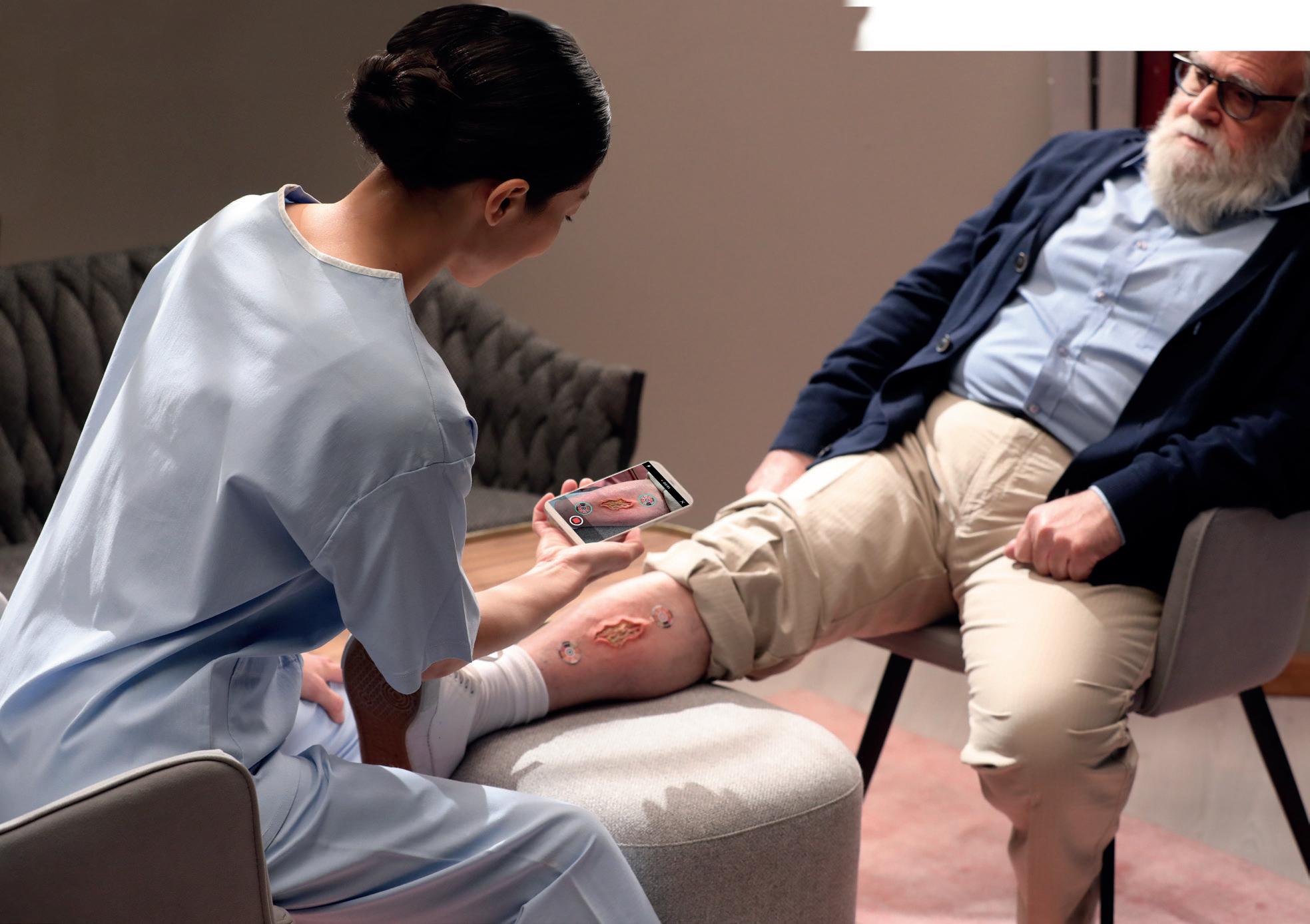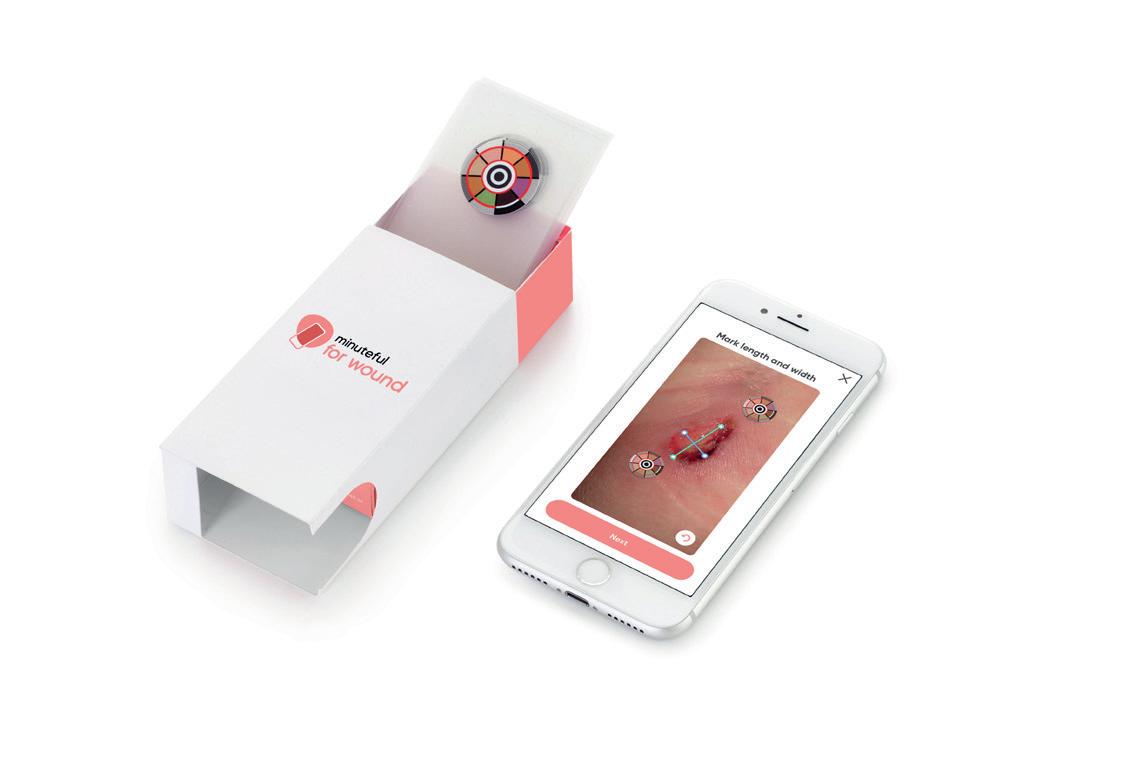
13 minute read
Saturday, June 26
(310)Telehealth: Solutions and Future Trends (W, O, PP)
5:45 PM EDT – 6:45 PM EDT PT CME
Advertisement
CONTACT HOURS: 1 AMA PRA CATEGORY 1 CREDITS™: 1 PHYSICAL THERAPY CONTACT HOURS: 1
Speakers:
Mary Mahoney, MSN, RN, CWOCN, CFCN Barbara Rozenboom, BSN, RN, CWON
This session will explore the increased use of telehealth as a method for providing care to wound ostomy patients. Telehealth technology has gained popularity recently out of necessity, as a way to provide care to patients who are isolated during the pandemic. Telehealth has been utilized for many years to fill the gap in rural and underserved areas where access to a provider is not convenient or readily available. Nomenclature used in the field of telehealth will be explained and scenarios reviewed in which telehealth monitoring is used in practice. Advantages and challenges using telehealth in wound ostomy practice will be discussed.
(311) Ostomy Dilemmas: Relocate, Revise, Reverse? (O, C)
5:45 PM EDT – 6:45 PM EDT CME
CONTACT HOURS: 1 AMA PRA CATEGORY 1 CREDITS™: 1
Speaker:
Elizabeth Raskin, MD, FACS, FASCRS
This talk with feature the dysfunctional ostomy and the surgical decision-making needed to improve function and patient quality of life. Options include medical management, wound ostomy care, and surgical interventions. We will discuss the concepts of revision, relocation, and reversal of ostomies.
(309)Caring for Malignant Wounds: What’s the
Microbiome Got to Do With It? (W) 30
6:15 PM EDT – 6:45 PM EDT
CONTACT HOURS: 0 .5 PHARMACOLOGY CREDIT: 0 .25 AMA PRA CATEGORY 1 CREDITS™: 0 .50 PHYSICAL THERAPY CONTACT HOURS: 0 .50
Speaker:
Stephanie Yates, MSN, RN, CWOCN, ANP-BC
Malignant fungating wounds (MFW) are present in 5-14% of advanced cancer patients in the US. They often occur within the last 6 months of life and are associated with symptoms that make the lives of cancer patients increasingly difficult, serving as a major source of emotional distress and poor quality of life. Associations between the cutaneous microbiome of these wounds and severity of symptoms have been made and will be applied to the selection of treatment options used with these wounds.
Networking Event
6:45 PM EDT – 8:00 PM EDT
Join us for a free Networking Event to meet with other amazing nurses and healthcare professionals! Chat, sit back and relax, and enjoy a *magical* experience with... you guessed it... a MAGICIAN!
Winner of numerous awards, including Close Up Magician of the Year, Jon Armstrong has brought his amazing skills and magical comedy to prestigious audiences in over 30 countries worldwide. Now Jon will be coming to WOCNext 2021 to amaze you!
SATURDAY, JUNE 26, 2021
Early Morning Seminar
(EMS02) Basic Ostomy Management: From Surgery to Success (O) 7:30 AM EDT – 8:45 AM EDT
CONTACT HOURS: 0 .75
Speaker:
Joy Hooper, RN, BSN, CWOCN, OMS, WCC, AWCC
Most clinicians don’t enjoy every area of healthcare and ostomy management can be particularly perplexing at times. If ostomy management is not in your comfort zone - this workshop is for you! The discussion will help you understand several common ostomy surgeries and the hands-on-demonstrations will offer an opportunity to see how common ostomy products are used.
Morning Symposia Sessions
(S10) Real Life, Real Improvements: The Challenge of Preventing Pressure Injuries and Managing Wounds During Covid-19 Pandemic 9:00 AM EDT – 10:15 AM EDT
CONTACT HOURS: 0
Speakers:
Kelly McFee, APRN, DNP, FNP-C, CWS, CWCN-AP, FACCWS Catherine Milne, APRN, MSN, BC-ANP/CS, CWOCN-AP
SUPPORTED BY SMITH+NEPHEW
Following admission to a facility, medical device related pressure injuries occur more quickly than other types of
pressure injuries. This is especially significant to both the patient and caregiver population when considering the provision of care during the COVID-19 pandemic.
The first part of this symposium will discuss the implementation of a step-by-step system-wide pressure injury prevention program and the positive outcomes of a two-fold medical device related pressure injury prevention protocol by providing guidance to caregivers with personal protective equipment (PPE) and COVID-19 patients undergoing prone positioning to support lung function.
Simultaneously, managing wounds adds to the already overloaded healthcare system. Seventy percent of dressing changes are driven by schedules and unnecessary dressing changes consume valuable time that could be used for patient’s other clinical needs. The reality is that healthcare providers are asked to do more with less. The second part of the symposium will examine the T.I.M.E clinical decision support tool used as an evidenced-based, five-step approach that incorporates T.I.M.E principles into a framework that nurses and other professionals can follow within their procedural guidelines. Interactive reallife case studies will be discussed to help participants quickly identify the barriers to wound healing and gain confidence to make the right treatment choice.
The presenters will then review why ALLEVYN LIFE may be the ideal multi-layer foam dressing for use as part of a comprehensive pressure injury prevention plan and for the management of wound exudate.
(S11) Soft Convexity: Is it the Panacea for all Stomas? An International Panel Perspective 9:00 AM EDT – 10:15 AM EDT
CONTACT HOURS: 0
Speakers:
Andrew Bird, RN, BSc, PGCert, MSc Karla Lohnes, BScN, RN, WOCC(C) Janet Stoia Davis, RN, ET, CWOCN, CFCN, CEP Scarlett Summa, Bsc, RN Erin Testerman-Mitra, BSN, RN, CWOCN
SUPPORTED BY HOLLISTER INCORPORATED
Ostomy care changes and recent advances in Convexity barrier options are shaping new practice opportunities for WOC Nurses. Join us for an engaging conversation featuring an International panel of Ostomy care experts. The panel will discuss topics in ostomy care related to the use of soft convexity in clinical practice to improve patient outcomes. Janet Stoia Davis, RN, ET, CWOCN, CFCN, CEP, will moderate the discussion as her fellow WOC Nurses share their insights, experiences and best practices when using Soft Convexity.
(S12) Optimizing Healing in Chronic Wounds from Head to Toe with the Help of Negative Pressure Wound Therapy 9:00 AM EDT – 10:15 AM EDT
CONTACT HOURS: 0
Speaker:
Dot Weir, RN, CWON, CWS
SUPPORTED BY 3M MEDICAL SOLUTIONS
Join Dot Weir as she discusses her experience utilizing negative pressure wound therapy and see how she manages her patients’ wounds through her case studies.
General Session
(GS5) Cracking the Codes for MASD (W, O, C, PP) 10:30 AM EDT – 11:30 AM EDT
CONTACT HOURS: 1
Speakers:
Donna Bliss, PhD, RN, FGSA, FAAN Mikel Gray, PhD, FNP, PNP, CUNP, CCCN, FAANP, FAAN Laurie McNichol, MSN, RN, CNS, GNP, CWOCN, CWON-AP, FAAN
In this session the significance and process of proposing a change to the ICD 10 codes to include MASD conditions will be explained. Advocacy of the WOCN Society for its members, collaboration among society members, a policy consultant and an industry partners, and support from other professional societies will be highlighted.
Exhibit Hall Open
11:30 AM EDT – 2:00 PM EDT
Innovation Hub Sessions
(IH07) Pressure Injury: With Focus on Prevention, is Quality Treatment Overlooked? 11:45 AM EDT – 12:15 PM EDT
CONTACT HOURS: 0
Speaker:
Terry Treadwell, MD, FACS
PRESENTED BY URGO MEDICAL
In this session, Dr. Terry Treadwell will discuss the rising incidence of pressure injuries and the increased challenges
presented in pressure injury patients that impact treatment and treatment options. Even with incidence on the rise, literature and guidelines have very little consensus on treatment modalities. With a focus on hypochlorous acid preserved wound cleansers (HAPWOC), we will review the mounting evidence around this technology and why achieving a balance and understanding the relationship between efficacy and cytotoxicity can make material change in pressure injury treatment. More broadly, we will explore the relationship of efficacy and cytotoxicity and how considering this can lead to more aggressive interventions that reduce the risk of wound degradation and the devastating impacts of infection.
(IH08) Silicone Foam Dressings to Prevent Deep Tissue Injury 12:15 PM EDT – 12:45 PM EDT
CONTACT HOURS: 0
Speaker:
Robyn Strauss, ACNS-BC, RN, MSN, WCC
PRESENTED BY MÖLNLYCKE HEALTH CARE This session is about a quality improvement project regarding cardiac surgical patients in a large academic institution. Nurses applied a foam sacral dressing preoperatively, and it stayed on for up to 5 days post-op in the intensive care and step down units. The project demonstrated a significant decrease in the incidence of postoperative sacral deep tissue injuries. Ms. Strauss will take us through her journey to get this QIP off the ground, and the success they found with the prophylactic dressing.
(IH09) Clinical Considerations for Antimicrobial Protection of Surgical Devices and Intravascular Catheters 12:45 PM EDT – 1:15 PM EDT
CONTACT HOURS: 0
Speakers:
Joseph Hommes, BSN, RN, VA-BC Jessica Pehrson, MSN, RN, CWS, PHN
PRESENTED BY 3M HEALTHCARE
Join us for an interactive presentation that explores the complications and best practices for the management of surgical drains and bone pins. The presentation will review the current literature and trends and introduce an innovative and versatile solution to provide antimicrobial protection with the 3M™ Tegaderm™ CHG Chlorhexidine Gluconate Gel Pad.
(IH10) Changing Patient Outcomes with Incontinence Detection 1:15 PM EDT – 1:45 PM EDT
CONTACT HOURS: 0
Speakers:
Lauri Deary, MS, BSN, RN, HN-BC Michele Johansson, MSN, RN, CEN Whitney Lloyd, MBA, BSN, RN, CNML
PRESENTED BY HILLROM Join us to hear about how one medical institution utilized new incontinence detection technology to help change patient outcomes in the height of the COVID-19 pandemic.
Last December, Baystate Medical Center a 716-bed independent academic medical center in Springfield, Mass was looking for ways to improve patient care and increase caregiver effectiveness during an unprecedented time. They were worried about increased incidences of hospital-acquired pressure injuries (HAPIs) knowing that in many cases, HAPIs are preceded by patients’ prolonged exposure to moisture caused by incontinence and the pandemic has further exacerbated this threat because:
1. COVID-19 patients typically have characteristics and conditions (old age, immobility, comorbidities and low skin integrity) that increase their vulnerability to pressure injuries
2. COVID-19 safety protocols limit how often nurses can check patients for incontinence.
This lead them to implement the use of a technology that alerts caregivers to the presence of incontinence – the WatchCare® Incontinence Management system available on their Centrella® Smart+ MedSurg beds from Hillrom. Through implementing this technology, Baystate was able to have ‘eyes’ on patients behind closed doors knowing they’d be alerted to the earliest presence of moisture. This allowed them to address incontinence events sooner – reducing the patients exposure time to incontinence.
Learn more during the session about how the use of this technology changed outcomes, improved caregivers effectiveness and helped Baystate provide compassionate care in an otherwise trying time.
Concurrent Sessions
(401)Sexuality & Aging (W, O, C, F) PT CME
2:00 PM EDT – 3:00 PM EDT
CONTACT HOURS: 1 AMA PRA CATEGORY 1 CREDITS™: 1 PHYSICAL THERAPY CONTACT HOURS: 1
Speaker:
Jeannette Potts, MD
We will review perceptions about sexuality in the aged as well as the changing demographics of partnered sex over time. This will help us to reflect upon perceptions of aging as they relate to psychosocial, physiologic and emotional challenges. Gender differences and sexual orientation also influence the ways in which intimacy and sexuality are expressed through sickness and aging.
This will be followed by an exploration of the barriers to sexual activity ranging from cultural and psychosocial to physical and health related factors. As we shall see, aging in and of itself is not a barrier; however, certain conditions that increase in prevalence with aging can have significant negative impacts, such as diabetes, arthritis, incontinence and post surgical changes.
(402)Quality of Life and Long Term Outcomes in Individuals with Urinary Diversions (O, C) 2:00 PM EDT – 3:00 PM EDT
CONTACT HOURS: 1
Speaker:
Tatum Tarin, MD
Radical cystectomy and urinary diversion remains the gold standard in the treatment of invasive bladder cancer. After cystectomy, these patients undergo a significant period of postoperative recovery and they face physical, social, and emotional challenges which can greatly impact their quality of life. During this session, we will discuss the different types of urinary diversions, indications and contraindications for specific diversions, long term considerations, and quality of life after urinary diversion. A better understanding of these important factors can improve pre-operative consultation and improve patient satisfaction.
(403)Getting it Right: Identifying Lower Extremity
Ulcers (W, F) PT CME
2:00 PM EDT – 3:00 PM EDT
CONTACT HOURS: 1 PHARMACOLOGY CREDIT: 0 .25 AMA PRA CATEGORY 1 CREDITS™: 1 PHYSICAL THERAPY CONTACT HOURS: 1
Speaker:
Suzie Ehmann, PT, DPT, CWS, CLT-LANA
Evaluation and successful management of lower extremity ulcerations requires practical knowledge of anatomy and physiology as well as knowledge of compression textiles. Appropriate compression selection and application is an essential component of both wound healing and edema management. Although most think of compression as simple elastic bandages, today’s wound care marketplace offers a plethora of unique compression textile options including both bandages and garments. With all the choices available, navigating the compression selection and application process can be a daunting task to even the most seasoned clinician. Utilizing the S.T.R.I.D.E. approach to compression selection, the attendee will be given a playbook on how to critically examine a patient’s presentation and match it to an appropriate compression product. Utilizing case examples, the attendee will walk away with practical tips to compression selection, modification and application.
(404)Ostomy Case Presentations Across the
Continuum: Audience Discussion (O) CME
2:00 PM EDT – 3:00 PM EDT
CONTACT HOURS: 1 PHARMACOLOGY CREDIT: 0 .25 AMA PRA CATEGORY 1 CREDITS™: 1
Speakers:
Christine Baker, MSN, APRN, CWOCN Janice Colwell, APRN, CWOCN, FAAN
This interactive session will pose case presentations, clinical situations and problems that are encountered in the daily practice of ostomy care. The cases will include pediatric and adult patients, presented by two advanced practice WOC nurses. The audience will be asked to provide suggestions for care, to point out areas that may not have a solution and to suggest what needs to be considered when managing challenging patient presentations. The attendees are the presenters; this session will be a moderated peer to peer discussion with questions and answers from the audience. Come prepared to discuss ostomy practice with your WOC nurse colleagues!
General Sessions
(GS6) Not All Abuse Leaves Bruises: Social Bullying in Academic and Clinical Nursing: Implications for a
Healthy Workplace (PP) CME
3:15 PM EDT – 4:15 PM EDT
CONTACT HOURS: 1 AMA PRA CATEGORY 1 CREDITS™: 1 PHYSICAL THERAPY CONTACT HOURS: 1
Speaker:
Janice Beitz, PhD, RN, CS, CNOR, CWOCN-AP, CRNP, ANEF, FNAP, FAAN
Social Bullying is a phenomenon detrimentally affecting both academic and clinical nursing. Contributing to both clinician and faculty turnover and dissatisfaction, social bullying is characterized by power inequities and occurs over time. Social bullying is particularly damaging when the perpetrator is a leader or manager. This session will describe the phenomenon of social bullying, explain its effects on academic and clinical organizations, and analyze approaches to diminish its effects and promote a healthy workplace.
(GS7) A Conversation to Motivate Smart Talk: Patient Perspective to Engage the WOC Nurse (W, O, C, PP)
4:15 PM EDT – 5:15 PM EDT PT
CONTACT HOURS: 1 PHYSICAL THERAPY CONTACT HOURS: 1
Speakers:
Derick Fage Joseph Glassbrenner Jonathan Moeller Anna Reinhart
People experiencing an ostomy, chronic wounds or fecal incontinence often experience a range of quality-of-life challenges throughout their life. Some of these may include economic challenges related to employment, sexuality, psychosocial issues, social and family relationships. Evidence shows WOC Nurses positively impact Quality of Life and help address the challenges these individual’s encounter as they transition to a new normal. What questions do the people experiencing these challenges acknowledge that they could have asked their WOC Nurse and/or provider in search of additional support?
Derek dealt with fecal incontinence from childhood into adulthood. Joe lives with a J-Pouch and experienced a previous ostomy. Johnathan endured several surgical procedures, a myocutaneous flap and is now in full recovery after dealing with a chronic trochanteric wound. Anna lives with an ileostomy after multiple surgeries, experienced a failed J Pouch and a pregnancy while living with her ostomy. Each have unique experiences to share on how to help patients like themselves to manage the challenges they each endure. Each individual story of coping and acceptance will provide WOC Nurses tools and clinical pearls to support an environment conducive to health and wellness.
Grand Finale & Closing Remarks 5:15 PM EDT – 5:30 PM EDT
CONTACT HOURS: 0
Speakers:
Dea Kent, DNP, RN, NP-C, CWOCN Stephanie Yates, MSN, RN, ANP-BC, CWOCN Sunniva Zaratkiewicz, PhD, RN, CWCN
CONCURRENT EDUCATION SESSIONS HAVE BEEN SUPPORTED BY AN UNRESTRICTED EDUCATIONAL GRANT FROM CONVATEC INC.








